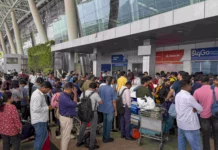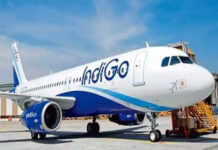Scenic land of Nagas & World War II battles
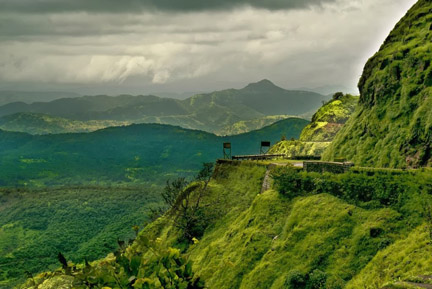 A scenic town blessed with breathtaking natural beauty, Kohima is the capital city of Nagaland and lies complacently shrouded at the eastern frontiers of the mighty Himalayas. The modern city of Kohima was built by the British to enjoy the eastern region.
A scenic town blessed with breathtaking natural beauty, Kohima is the capital city of Nagaland and lies complacently shrouded at the eastern frontiers of the mighty Himalayas. The modern city of Kohima was built by the British to enjoy the eastern region.
This is the very place where the World War-II battle took place and thousands of soldiers sacrificed their lives. The majority of Nagas and Kukis reside in the region and protect their unique culture and identity.
The colorful costumes of the local people, joyous and familiar behavior makes it a wonderful experience to visit this city. The astounding places of Kohima that attract tourists are the Dzukou valley, Bara Basti and Cathedral of Reconciliation.
Kohima town is the second largest urban area of Nagaland after Dimapur-Chumukedima. ‘Kohima Village’, known as ‘Bara Basti’ or ‘large village’, is the second largest village in Asia. The city also has a great cemetery for the soldiers who died in the war and is maintained by the Commonwealth War Graves Commission.
Events / Festivals
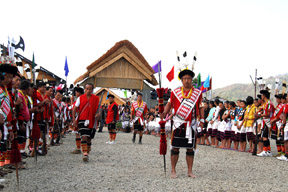 Festivals in Kohima are celebrated with much grandeur. The major festivals in Kohima are:
Festivals in Kohima are celebrated with much grandeur. The major festivals in Kohima are:
Ngada festival: The festival is celebrated majorly by Rengmas tribe to rejoice the ending of the agricultural year. Ngada falls in the end of November and is commemorated with joyfulness and jubilation.
Moatsu: A beautiful festival of the Aos tribe, Moatsu festival is celebrated after sowing has ended. The people celebrate this festival for three days in the month of May.
Hornbill Festival: Held in the month of December, Hornbill Festival is a cultural festival of dance, sport, art, food and performances etc. It is an extremely nice festival and all tribes of Nagaland celebrate this festival with each other along with the tourists with immense zeal.
Zeliang: This festival is celebrated in the months of February and October.
Places to visit
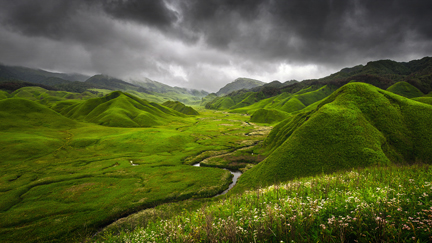
Khonoma: The Angami tribe’s village of Khonoma in the Western part of Kohima District is popularly known amongst locals and outsiders for its environmental consciousness amongst locals. Added to its environmental conscious community, the village also boasts of well maintained sanitation, abundant greenery and a typical agricultural system called “Alder based jhum cultivation”.
One may pose a potent question that how can a village be an attraction in itself, but it is one of those rare villages in India which is termed as a ‘Green Village.’ It is around a 3 crore project sponsored by Government of India’s Tourism Ministry. Literally green environment, well conserved trees and plants and agriculturally rich land came together to take the village to the peak of eco-tourism.
Japfu Peak: Flaunting itself as the second highest peak of Nagaland, Japfu Peak in Kohima is no doubt an eye-catching site nestled at a height of around 3048 meters above sea level. The peak is not only an attraction for trekkers, but also for photographers and nature lovers who want to witness and capture panoramic vistas of nature.
Blanketed with lush green vegetation, with the backdrop of snow-clad Himalayas, the entire Japfu Peak looks like a river full of emeralds opening up to gorgeous views of adjoining villages and cities. Mostly bestowed with subtropical vegetation, those visiting the peak can enjoy the sweet murmur of various hill birds.
Cathedral of Reconciliation: A religious and architectural landmark in Kohima, Cathedral of Reconciliation is the main church of the bishop of the diocese of Kohima. The church’s semi-circular building with a facade in line with traditional Naga house and modern architectural ideas describe in details the architectural brilliance of the ancient era.
Construction work of Cathedral of Reconciliation began in 1986 and the consecration of the same was done in 1991. The specially carved places for baptism, adoration and confession along with well designed galleries to accommodate as many as 4500 people, all showcase extraordinary appeal. Interestingly, the construction of the cathedral was funded by the Japanese who wanted to build a monument and dedicate the same to those Japanese soldiers who sacrificed their lives in the battle of Kohima during World War II.
War Cemetery: War Cemetery in Kohima is a significant historical landmark dedicated to as many as 10,000 brave soldiers of the 2nd British Division of Allied Forces who gave up their lives in World War II at Kohima during the year 1944. Kohima War Cemetery, earlier known as Garrison Hill, initially served as a tennis ground of the Deputy Commissioner and later got transformed into a battle ground.
The cemetery is designed in a series of terraces where stone steps lead to the way. Beautifully covered with grass and roses, the plots of the cemetery looks like a colorful blanket sculpted with stories of brave hearts who laid down their lives for the nation. As around 17,000 soldiers including British and Indian were reportedly killed, missing and wounded, the British before leaving India decided to erect such a memorial in the memories of the valiant comrades.
Bara Basti: Though it literally means ‘big village’, Bara Basti is believed to be the most ancient village of Kohima as well. It is also known to be the second largest and most populated village of Asia. Originally built by Angami ancestors, the village is presently serving as a heritage place for Naga tribe.
A large traditional wooden gate elaborately carved with weapons, warriors and the skull of Mithun, a symbol of prosperity, mark the entrance of the village. The village is divided into four khels or communities namely.
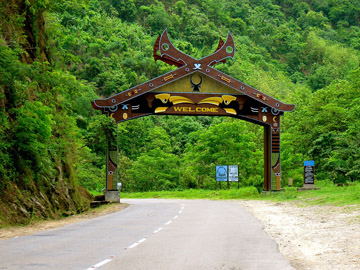 Dzukou Valley: Have you ever imagined walking through a colorful natural carpet decorated with colorful flowers, emerald green hills, murmur of placid rivulets and thick green forests? If not, then take a trekking trail through easy to moderate gradients to Dzukou Valley in Kohima, Nagaland. Dzukou Valley is nestled at an altitude of approximately 2438 meters above sea level at a distance of nearly 24km from Kohima town.
Dzukou Valley: Have you ever imagined walking through a colorful natural carpet decorated with colorful flowers, emerald green hills, murmur of placid rivulets and thick green forests? If not, then take a trekking trail through easy to moderate gradients to Dzukou Valley in Kohima, Nagaland. Dzukou Valley is nestled at an altitude of approximately 2438 meters above sea level at a distance of nearly 24km from Kohima town.
Because of vast undulating meadows, the valley is popularly known as “Valley of Flowers of North East”. A visual treat for nature lovers and an adrenaline stimulator for adventure junkies, this beautiful valley of Nagaland is in fact one of the best and biggest kept secrets of India. Lilies, aconitum, euphorbia and multi-colored rhododendrons along with two gently meandering streams, Dzukou and Japfü rivers, heighten its beauty and pull in maximum tourist population to its heart.
Best time to visit
Kohima is an ideal place to visit in the months of October to May
How to Reach
By Air: The nearest domestic airport is Dimapur, roughly 74 kms from Kohima. Dimapur Airport is well connected to major cities of India like Guwahati, Imphal, Kolkata and Dibrugarh. The second nearest domestic airport is Imphal, 145 kms from Kohima. It has regular flights to the places such as Aizawl, Bangalore, Delhi, Kolkata and Silchar.
By railways: The nearest railway station is located in Dimapur, 74 kms from Kohima. It is well connected to Guwahati and Kolkata.



